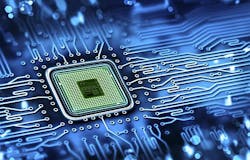Air Force to kick off trusted computing program to give military access to COTS microelectronics
WRIGHT-PATTERSON AFB, Ohio – U.S. Air Force researchers are kicking off a program to develop new trusted computingmicroelectronics technologies to enable broader use of commercial off-the-shelf (COTS) electronic components in military systems.
Officials of the Air Force Research Laboratory have issued a presolicitation (FA8650-18-S-1201) for the Assured and Trusted Microelectronics Solutions (ATMS) program. A formal solicitation is expected as early as this month.
The rapid improvement cycle for semiconductor technology and systems-on-a-chip (SoC) has made process and equipment upgrades very expensive, triggering state-of-the-art foundry operations to consolidate into a few large companies mainly in Asia, Air Force researchers explain.
The resulting lack of trusted, U.S.-based foundries has become a significant concern for the U.S. Department of Defense (DOD) because commercial state-of-the-art foundries for defense-related application-specific integrated circuit (ASIC) development may not meet security and trusted computing requirements.
The ATMS program will seek to ensure that microelectronics from commercial foundries are trusted, assured, and protected. This applies to currently fielded microelectronics no longer in production; microelectronics in production; and next-generation cutting-edge microelectronics.
Trusted means confidence that there is no malicious content. Assured means microelectronics parts have verified function with no extra functions. Protected, meanwhile, means these microelectronics parts can prevent unauthorized disclosures as to their designs.
The ATMS program will try to increase the availability of COTS trusted microelectronics that are sustainable and reliable across military mission lifetimes; are purchased exactly as specified and without additions or alterations; and that maintain stringent IP protection during manufacturing and after fielding.
Ultimately, military leaders want the ability to field COTS ASICs, systems-on-chip, and field-programmable gate arrays (FPGAs) without putting military systems at risk. The goal is to enable rapid military system modernization and flexibility, increased performance, and less need for unique DOD systems.
To do this, Air Force researchers want to develop technologies that have built-in trust measures; that accelerate circuit development for military systems, and ensure performance for DOD systems.
Air Force researchers are interested in embedded design assurance to ensure that the DOD maintains access to advanced and legacy integrated circuit technologies.
Examples of embedded design assurance include mechanisms to ensure the integrity of commercial off-the-shelf (COTS) FPGAs through 3PIP analysis, tools, and techniques of the FPGA hardware and bitstream; metrics for FPGA assurance; verification methods to ensure functions; traceability throughout the supply chain; and security circuit implementations and architectures.
Researchers also are interested in new microelectronics test and measurement technologies to verify the trust and assurance of components and systems.
These could include embedded ASIC structures to assist in post fabrication analysis; high-volume technologies to characterize supply chain risk; non-destructive test techniques; algorithms to reduce analysis time; low-cost evaluation techniques; and fusion technologies that capitalize on several data sets.
Researchers also want enhanced microelectronics fabrication and packaging at high-mix, low-volume foundries. This could involve how 3D and 2.5D packaging could help protect IP and assure trust; advanced integrated photonics; flexible hybrid manufacturing; and technologies that may provide additional security.
The upcoming ATMS program also involves new design, manufacturing, and assessment for trusted radiation-hardened electronics in next-generation strategic systems.
Related: Mercury acquisition capitalizes on RF, cyber, and anti-tamper technologies
This could include rad hard by design (RHBD) libraries and new ways to meet strategic radiation levels; dose rate radiation effects testing for COTS devices; radiation testing for FPGAs; and new ways to capitalize on commercial technology and COTS devices for high-reliability strategic-hardened applications.
Air Force researchers are not requesting white papers or formal proposals until the formal ATMS program solicitation is released sometime this month, or later. Several contract awards of one to three years are expected, and the total program could be worth as much as $25 million, researchers say.
For technical questions or concerns contact the Air Force's Glen Via by email at [email protected] or by phone at 937-713-8694. For contracting questions or concerns contact Adam Estess by email at [email protected]. Also contact Jo Ann Sillaman by email at [email protected], or by phone at 937-713-9965.
More information is online at https://www.fbo.gov/spg/USAF/AFMC/AFRLWRS/FA8650-18-S-1201/listing.html.
Ready to make a purchase? Search the Military & Aerospace Electronics Buyer's Guide for companies, new products, press releases, and videos

